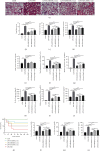Differential Lung Protective Capacity of Exosomes Derived from Human Adipose Tissue, Bone Marrow, and Umbilical Cord Mesenchymal Stem Cells in Sepsis-Induced Acute Lung Injury
- PMID: 35265265
- PMCID: PMC8898768
- DOI: 10.1155/2022/7837837
Differential Lung Protective Capacity of Exosomes Derived from Human Adipose Tissue, Bone Marrow, and Umbilical Cord Mesenchymal Stem Cells in Sepsis-Induced Acute Lung Injury
Abstract
Exosomes derived from human mesenchymal stem cells (hMSCs) have the capacity to regulate various biological events associated with sepsis-induced acute respiratory distress syndrome (ARDS), including cellular immunometabolism, the production of proinflammatory cytokines, allowing them to exert therapeutic effects. However, little is known about which type of hMSC-derived exosomes (hMSC-exo) is more effective and suitable for the treatment of sepsis-induced ARDS. The purpose of this study is to compare the efficacy of hMSC-derived exosomes from human adipose tissue (hADMSC-exo), human bone marrow (hBMMSC-exo), and human umbilical cord (hUCMSC-exo) in the treatment of sepsis-induced ARDS. We cocultured lipopolysaccharide- (LPS-) stimulated RAW264.7 macrophage cells with the three kinds of hMSCs and found that all hMSCs reduced the glycolysis level and the content of lactic acid in macrophages. Accordingly, the expression of proinflammatory cytokines also decreased. Notably, the protective effects of hMSCs from adipose tissue were more obvious than those of bone marrow and umbilical cord hMSCs. However, this protective effect was eliminated when an exosome inhibitor, GW4869, was added. Subsequently, we extracted and cocultured hMSC-derived exosomes with LPS-stimulated RAW264.7 cells and found that all three kinds of exosomes exerted a similar protective effect as their parental cells, with exosomes from adipose hMSCs showing the strongest protective effect. Finally, an experimental sepsis model in mice was established, and we found that all three types of hMSCs have obvious lung-protective effects, in reducing lung injury scores, lactic acid, and proinflammatory cytokine levels in the lung tissues and decreasing the total protein content and inflammatory cell count in the bronchoalveolar lavage fluid (BALF), and also can attenuate the systemic inflammatory response and improve the survival rate of mice. Intravenous injection of three types of hMSC-exo, in particular those derived from adipose hADMSCs, also showed lung-protective effects in mice. These findings revealed that exosomes derived from different sources of hMSCs can effectively downregulate sepsis-induced glycolysis and inflammation in macrophages, ameliorate the lung pathological damage, and improve the survival rate of mice with sepsis. It is worth noting that the protective effect of hADMSC-exo is better than that of hBMMSC-exo and hUCMSC-exo.
Copyright © 2022 Huimin Deng et al.
Conflict of interest statement
The authors declare that they have no competing interests.
Figures






Similar articles
-
Bone marrow mesenchymal stem cell-derived exosomes alleviating sepsis-induced lung injury by inhibiting ferroptosis of macrophages.Int Immunopharmacol. 2025 Jun 17;158:114789. doi: 10.1016/j.intimp.2025.114789. Epub 2025 May 13. Int Immunopharmacol. 2025. PMID: 40367688
-
ADSCs-derived exosomes suppress macrophage ferroptosis via the SIRT1/NRF2 signaling axis to alleviate acute lung injury in sepsis.Int Immunopharmacol. 2025 Jan 27;146:113914. doi: 10.1016/j.intimp.2024.113914. Epub 2024 Dec 27. Int Immunopharmacol. 2025. PMID: 39732105
-
Comparison of efficacy of exosomes derived from human umbilical cord blood mesenchymal stem cells in treating mouse acute lung injury via different routes.Front Pediatr. 2025 May 29;13:1560915. doi: 10.3389/fped.2025.1560915. eCollection 2025. Front Pediatr. 2025. PMID: 40510682 Free PMC article.
-
The therapeutic potential of stem cell-derived exosomes in the ulcerative colitis and colorectal cancer.Stem Cell Res Ther. 2022 Apr 1;13(1):138. doi: 10.1186/s13287-022-02811-5. Stem Cell Res Ther. 2022. PMID: 35365226 Free PMC article. Review.
-
Macrophages in sepsis-induced acute lung injury: exosomal modulation and therapeutic potential.Front Immunol. 2025 Jan 7;15:1518008. doi: 10.3389/fimmu.2024.1518008. eCollection 2024. Front Immunol. 2025. PMID: 39840035 Free PMC article. Review.
Cited by
-
Human Placental Mesenchymal Stem Cells and Derived Extracellular Vesicles Ameliorate Lung Injury in Acute Respiratory Distress Syndrome Murine Model.Cells. 2023 Nov 29;12(23):2729. doi: 10.3390/cells12232729. Cells. 2023. PMID: 38067158 Free PMC article.
-
Metabolic Reprogramming and Its Regulatory Mechanism in Sepsis-Mediated Inflammation.J Inflamm Res. 2023 Mar 20;16:1195-1207. doi: 10.2147/JIR.S403778. eCollection 2023. J Inflamm Res. 2023. PMID: 36968575 Free PMC article. Review.
-
How Extracellular Nano-Vesicles Can Play a Role in Sepsis? An Evidence-Based Review of the Literature.Int J Nanomedicine. 2023 Oct 16;18:5797-5814. doi: 10.2147/IJN.S427116. eCollection 2023. Int J Nanomedicine. 2023. PMID: 37869065 Free PMC article. Review.
-
Protective properties of extracellular vesicles in sepsis models: a systematic review and meta-analysis of preclinical studies.J Transl Med. 2023 Apr 17;21(1):262. doi: 10.1186/s12967-023-04121-7. J Transl Med. 2023. PMID: 37069645 Free PMC article.
-
Advances in mesenchymal stromal cell therapy for acute lung injury/acute respiratory distress syndrome.Front Cell Dev Biol. 2022 Aug 10;10:951764. doi: 10.3389/fcell.2022.951764. eCollection 2022. Front Cell Dev Biol. 2022. PMID: 36036014 Free PMC article. Review.
References
MeSH terms
LinkOut - more resources
Full Text Sources
Medical

